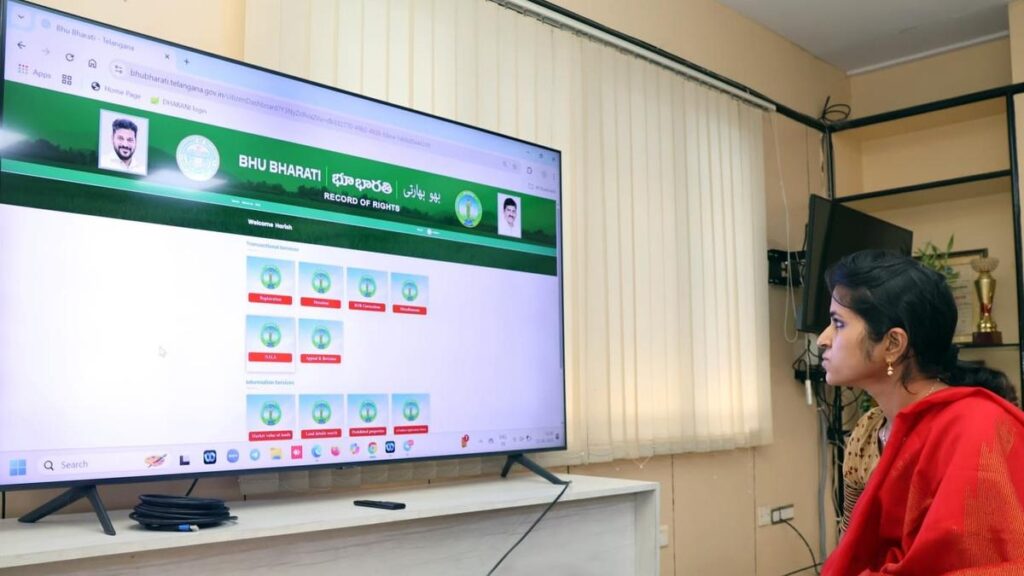
Sangareddy collector Kranti Valluru checking the Bhu Bharathi Portal.
| Photo Credit: MOHD ARIF
The story so far:
Telangana government has enacted the Telangana Bhu Bharati (Record of Rights) Act and formally launched the Bhu Bharati portal as a solution to land related issues which cropped up after the introduction of Dharani portal by the previous Bharat Rashtra Samiti (BRS) government.
The then government billed the Dharani portal as a one-stop solution for all land related transactions and claimed that 93% of land records were rectified through the Land Record Updation Programme (LRUP) [The exercise included digitisation of the records]. However, a major chunk of these disputes arose during the digitalisation process.
Scrapping the Dharani portal has been one of the main planks on which the Congress has contested the previous [2023] State Assembly elections and the results, especially in the rural areas, reflected the manner in which people suffered because of the Telangana Rights in Land and Pattadar Passbooks Act, 2020 and Dharani portal introduced by the BRS government.
Why were the new Act and portal introduced?
Within days of enactment of the 2020 Record of Rights Act and introduction of Dharani portal, a spate of grievances from the landowners started pouring in. There were complaints like Patta lands being put in the Part-B, the prohibited list, which contained over 18 lakh acres and those about the difficulties faced by landowners by the removal of enjoyment [displaying name of current owner of the property] column in the land registration documents. This resulted in mismatch between the extent of land in records and the actual land available on the ground.

There were complaints about missing survey numbers as also about lands being registered in the name of others without the knowledge of the actual owners. There were several instances where records were uploaded into Dharani portal without field inspections. People were desperate for these issues – which gave them sleepless nights – to be resolved.
Absence of accessible redressal mechanism
Complicating the woes of the landowners was the absence of redressal mechanism at the ground level as the previous government vested the entire power to address grievances in the district Collector and Chief Commissioner of Land Administration, who are usually not easily accessible. This has forced the affected families to take to legal recourse resulting in piling up of cases in the courts at different levels.
New act decentralises redressal systems
Realising the problems caused on account of the 2020 Act and Dharani, the Congress government has enacted the Telangana Bhu Bharati (Record of Rights) Act, 2025, to address these grievances amicably. In the process, the government took steps to decentralise the grievance redressal systems. The draft legislation was put in public domain seeking views and suggestions of the stakeholders, a practise reintroduced after several decades. The three-month-long exercise encompassed an expert committee holding discussions with farmers and other sections that were affected by Dharani portal and understanding the root causes behind their issues. The committee accordingly finalised its recommendations envisaging simpler methods for addressing the issues raised by the affected sections which ultimately resulted in the enactment of the Bhu Bharati Act.
Salient features of the new Act
The new Act provides option for rectification of errors in land records that cropped up since 2020 and assures that lands would be surveyed and maps prepared before initiating the process for registrations and mutations, thus making it litigation free to a large extent. It also assures to look into regularisation of sada bainamas (transactions on plain paper) on the basis of ground level facts while incorporating provision for time bound mutation of land titles in case of hereditary properties. A large number of properties were transferred on the basis of the sada bainamas.
Grievance redressal mechanism
An important feature of the Bhu Bharati Act is setting up grievance redressal mechanism at two levels enabling the aggrieved families to get a solution to their issues. The new Act enables landowners to register their grievances pertaining to land rights within one year from the date of operationalisation of the legislation. Besides the collector concerned, the grievances can be primarily addressed by the revue divisional officer (RDO) and can be escalated to the district collector concerned in case they remain unresolved at RDO level. The applicants can approach the land tribunal at the district level if he is not satisfied by the response. This is in sharp contrast with the previous system which forced people to approach civil courts for resolution
Farmers can get their grievances redressed free of cost
Farmers can get their grievances redressed free of cost unlike the previous system. In Dharani, farmers and landowners alike were asked to pay prescribed fee for registering their problems and they had to pay up again for escalating their grievance to a higher level if the issue was not resolved at that particular level.
The new Act has provision to scrap the rights of owners on the land if they are found guilty of acquiring the government, Bhoodan, assignment, endowments and Waqf lands irregularly.
New portal’s efficacy being tested
The Bhu Bharati portal has been made operational in four mandals in different districts initially to test the efficiency of the software and it will be gradually extended to other parts of the State before June 2 – Telangana formation day. This is to ensure that there is no scope for complaints on lapses in the land transactions.
Published – April 18, 2025 12:07 pm IST
Source:https://www.thehindu.com/news/national/telangana/telanganas-bhu-bharti-act-a-legislation-to-resolve-land-issues-explained/article69459966.ece

